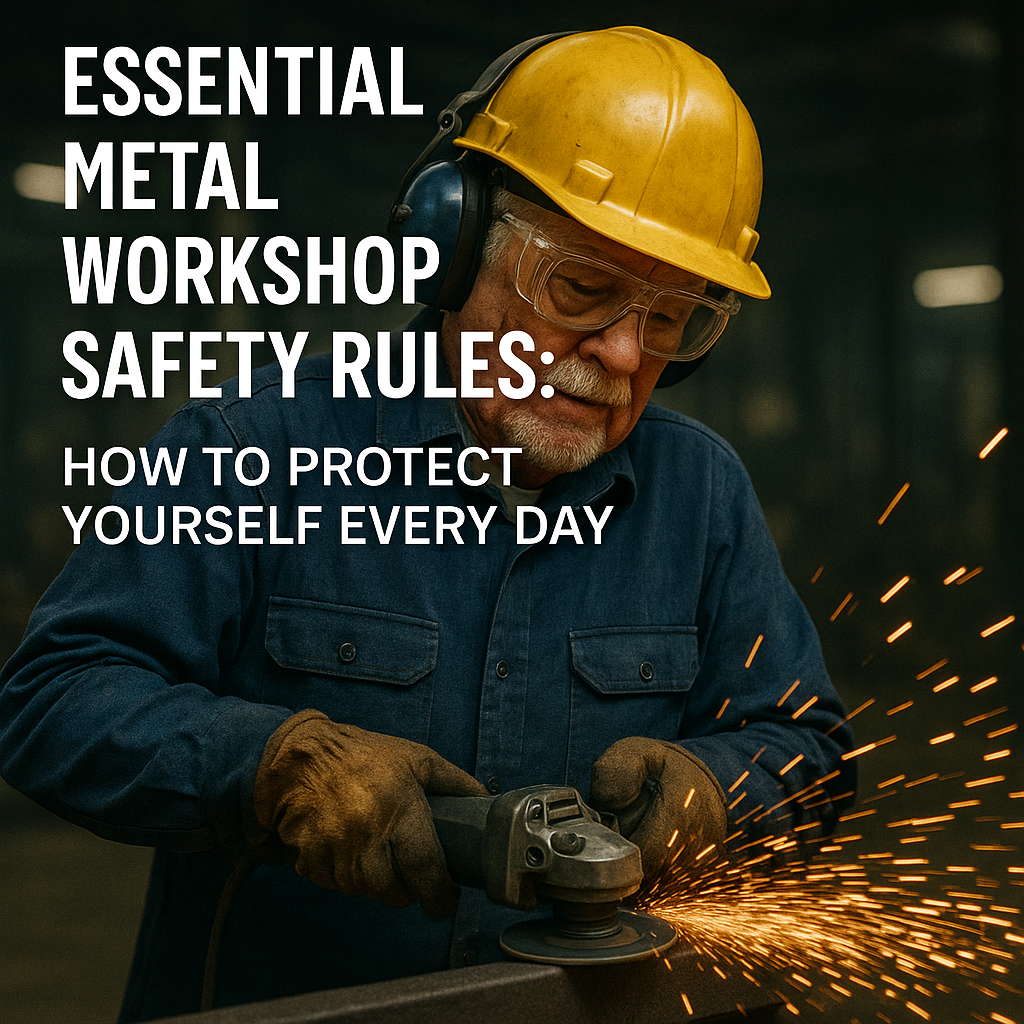At the beginning of every metalworking project, your most important tool isn’t a grinder or a welder — it’s metal workshop safety.
Following strict safety protocols not only protects your body but also preserves the quality of your work and ensures a long, successful career.

Whether you’re cutting, welding, grinding, or polishing, understanding and applying metal workshop safety rules is a non-negotiable foundation for success.
10 Important Safety Rules in a Metal Workshop
Practicing metal workshop safety starts with these ten essential rules:
- Always Wear PPE: Never start work without proper personal protective equipment.
- Inspect Tools Before Use: Check machines and hand tools for damage or defects.
- Keep the Workspace Clean: A cluttered shop is a dangerous shop.
- Use Machines Properly: Follow the manufacturer’s guidelines at all times.
- Be Aware of Hot Surfaces: Metals can remain dangerously hot after cutting or welding.
- Handle Chemicals Carefully: Solvents, cleaners, and fluxes must be used and stored safely.
- Never Work When Tired: Fatigue significantly increases accident risks.
- Secure Your Workpieces: Use clamps and vises to prevent slipping.
- Beware of Sparks and Fire Hazards: Keep flammable materials away from welding areas.
- Stay Focused: Distractions in the workshop can be deadly.
By sticking to these 10 metal workshop safety rules, you can drastically minimize risks and injuries in any project.
Common Hazards of Metal Work

Understanding the hazards inherent to metalwork is the first step toward effective prevention.
- Sharp Edges and Burrs: Can cause deep cuts or puncture wounds.
- Flying Debris: Sparks, hot shards, and splinters can injure eyes and skin.
- Noise Exposure: Prolonged exposure can lead to hearing loss.
- Chemical Burns: Caused by exposure to solvents, oils, or metal treatments.
- Respiratory Hazards: Fumes from welding and grinding can harm the lungs.
- Fire and Explosion Risks: Especially near flammable materials.
- Crush Injuries: From heavy equipment or falling metal stock.
Resources like OSHA and Safe Work Australia (both DoFollow links) highlight these risks and offer mitigation strategies for workers and employers.
Required PPE for Metal Work
When it comes to metal workshop safety, the right PPE (Personal Protective Equipment) makes all the difference:
| PPE Item | Purpose |
|---|---|
| Safety Glasses or Goggles | Protects against flying debris and sparks |
| Face Shield | Full-face protection during grinding or cutting |
| Hearing Protection | Earmuffs or plugs reduce noise exposure |
| Respirators or Dust Masks | Prevent inhalation of fumes and dust |
| Heat-Resistant Gloves | Protects hands from hot metal and sharp edges |
| Steel-Toed Boots | Shields feet from heavy falling objects |
| Flame-Resistant Clothing | Guards against welding sparks and hot surfaces |
| Welding Helmet | Specialized eye and face protection from UV rays and sparks |
Internal linking reminder: Check out our detailed guide on Essential PPE for Different Job Roles: A Complete Breakdown for more in-depth recommendations.
How to Avoid Injuries While Working with Metals
Proactively managing your environment and behavior is key to metal workshop safety and avoiding injuries:
- Proper Training: Ensure all users are trained on the correct use of each tool and machine.
- Good Posture: Maintain ergonomically safe working positions to prevent strain injuries.
- Tool Maintenance: Keep cutting and grinding tools sharp and well-maintained.
- Use Barriers: Shields and barriers can protect bystanders from sparks and debris.
- Plan Your Work: Know your next move to avoid sudden, dangerous actions.
- Ventilate Work Areas: Welding and cutting should always be done in well-ventilated spaces.
- Hydrate and Rest: Stay alert and physically prepared for physically demanding work.
As emphasized by Canadian Centre for Occupational Health and Safety (DoFollow link), consistent attention to detail and maintaining physical fitness are equally crucial to a safe workshop environment.
Conclusion: Build a Strong Foundation with Metal Workshop Safety
Success in a metal workshop isn’t just about craftsmanship — it’s about protection, awareness, and discipline. Metal workshop safety must always come first, from the first spark to the final polish.

By rigorously following the 10 core rules, respecting the hazards, equipping yourself with the right PPE, and practicing safe habits, you can transform your workspace into a fortress of productivity and well-being.
No project is too small to demand full safety practices.
In metalwork, safety isn’t optional — it’s the strongest weld that holds everything together.

No comments yet